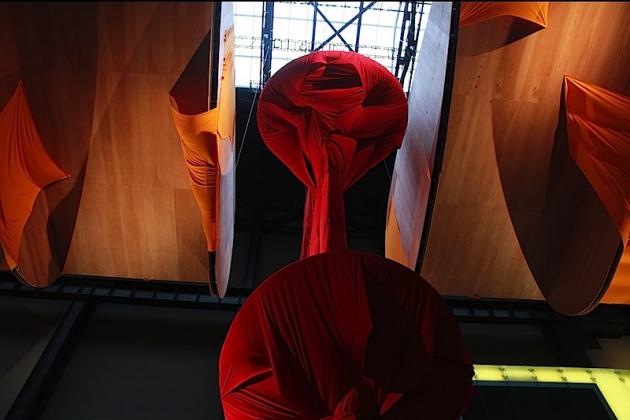During World War II, when Richard Tuttle was but a young boy, his father had a nervous breakdown, which effectively tore down his hitherto patriarchal authority. The future celebrated North American sculptor, painter, and textile artist reacted by retreating to his front porch in New Jersey, and had an intensely formative time of reflection. Tuttle claims it defined his past, current, and future life. Running like a thread through his career, that moment remains a fertile and foundational inspiration to this day.
These various strands are knitted together in a new three-part project: an eye-catching commission at the Tate Modern’s Turbine hall, a five-decade retrospective at the Whitechapel Gallery, and a revelatory publication based on Tuttle’s own collection of historic and contemporary textiles from around the world. ‘I Don’t Know. The Weave of Textile Language’ is the name given to both the Turbine sculpture and the wider retrospective at the Whitechapel Gallery, and exemplifies the artist’s earnest agnosticism.
Strange then, that Tuttle – an archetypal Post-Minimalist – was chosen for the newly-commissioned sculpture in the Tate’s cavernous Turbine Hall, after new sponsors Hyundai recently guaranteed Turbine projects until 2025. Vastly unlike his diminutive ‘3rd Rope Piece’ (1974), the 3-inch long piece of rope featured at the Whitechapel gallery, Tuttle’s Turbine installation spans an impressive 40 metres wide. It conjures up images of a spread-eagled albatross, a tsunami of primary colours, and a Wright Brothers-style airplane. Variously taut and sagging, scarlett and saffron fabrics envelop the structure, while occasionally panels of bare plywood poke out. Some parts are liberally piled, like a rose or a robe, whereas others have mirrors concealed beneath, to add greater luminosity. In fact, Tuttle insisted on installing his own lighting, which is not at all universal and uniform. It powerfully contrasts with Tate Modern’s metallic, post-industrial aesthetic; even more so, with the onset of London’s autumn.
It is the largest work Tuttle has ever created, but the artist is keen to stress his focus on scale rather than size. This what distinguishes Tuttle from his masculinised sculptor peers, such as Richard Serra, whose industrial approach is currently showing at both of London’s Gagosian galleries. It’s a distinction that Tuttle made even clearer, when he explained: “the difference between male and female art is that between works that either take up space, or those that make space, respectively.”
Exactly that: the creation of space, is what can be found at the Whitechapel gallery retrospective. Spanning from the 1960s to today, Tuttle’s oeuvre explores the politics of fibre, in the most delicate of approaches. ‘Fiction Fish 7’ (1992), for example, is a tiny, colourful cylinder of thread – barely an inch above the ground – that, almost imperceptibly, leads a line of fishing wire, all the way to the top of ceiling. The Section VII, Extensions series (2007) are intertwined, intricate works that are as arresting as the towering canvases of Pop and Abstract Expressionism, that Tuttle is reacting to.
It may not be immediately apparent, but Tuttle is a subversive in many ways. His exhibition at New York’s Whitney in the 1970s proved extremely divisive, and even now, Tuttle diverges from the canon: he hammers works to the wall with nails, sticks them together with blu-tack, mounts them at them at shin or ceiling-height, and replaces straightforward labels with poems (Tuttle is a published poet).
This discourse between text and textile is something that Tuttle constantly returns to. Perceived obstacles no.72 (oil painting #1) – no.80 (1991) are a set of paintings on Belgian linen made to look like mathematics grid paper. ‘Type’ (2004) is a series of 26 sketches, swirls, scribbles, splodges; as if Tuttle’s take on the alphabet. In doing so, he transfers the very carnal, tactile process to cerebral thoughts within the mind. This intimacy can equally be seen in re-made key sculpture ‘Ten Kinds of Memory and Memory Itself’ (1972) as well as in the playful palette of the multi-layered collage that is ‘Clutter’ (2008-12).
‘I Don’t Know. The Weave of Textile Language’ refers to the mystery that Tuttle finds in textiles: he feels that we need to sharpen our senses because textiles run the risk of being overlooked. The 73-year-old’s reputation is clearly stronger in the US than the UK – the Bowdoin College Museum of Art in Maine is hosting the first retrospective of his prints alone – but Tuttle’s use of humble, everyday materials, in such an intimate manner, offer plenty of subtlety. The question that remains, however, is if the man who claims his art to be “gender free” is impressive because of his work, or the universal space that it captures.
Words/Photo: Peter Yeung © Artlyst 2014
Richard Tuttle: I Dont Know. The Weave of Textile Language is on at Tate Modern’s Turbine Hall until 6 April 2015 and on at the Whitechapel Gallery until 14 December 2014.

